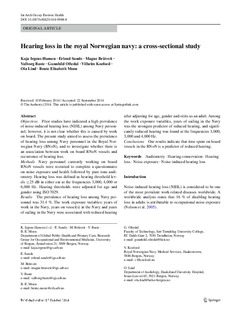Hearing loss in the royal Norwegian navy: a cross-sectional study
Irgens-Hansen, Kaja; Sunde, Erlend; Bråtveit, Magne; Baste, Valborg; Oftedal, Gunnhild; Koefoed, Vilhelm F.; Lind, Ola; Moen, Bente Elisabeth
Journal article, Peer reviewed

Åpne
Permanent lenke
http://hdl.handle.net/11250/281956Utgivelsesdato
2014-10-07Metadata
Vis full innførselSamlinger
Sammendrag
Objectives Prior studies have indicated a high prevalence of noise-induced hearing loss (NIHL) among Navy personnel; however, it is not clear whether this is caused by work on board. The present study aimed to assess the prevalence of hearing loss among Navy personnel in the Royal Norwegian Navy (RNoN), and to investigate whether there is
an association between work on board RNoN vessels and occurrence of hearing loss.
Methods Navy personnel currently working on board RNoN vessels were recruited to complete a questionnaire on noise exposure and health followed by pure tone audiometry.
Hearing loss was defined as hearing threshold levels ≥25 dB in either ear at the frequencies 3,000, 4,000 or 6,000 Hz. Hearing thresholds were adjusted for age and
gender using ISO 7029.
Results The prevalence of hearing loss among Navy personnel was 31.4 %. The work exposure variables: years of work in the Navy, years on vessel(s) in the Navy and years
of sailing in the Navy were associated with reduced hearing after adjusting for age, gender and otitis as an adult. Among the work exposure variables, years of sailing in the Navy was the strongest predictor of reduced hearing, and significantly
reduced hearing was found at the frequencies 1,000, 3,000 and 4,000 Hz.
Conclusions Our results indicate that time spent on board vessels in the RNoN is a predictor of reduced hearing.